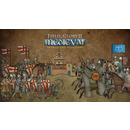Kupi Field of Glory II: Medieval - Swords and Scimitars (PC)
 Rasprodano
Rasprodano
Cijena: 14,79 €
Platforma: PCŽanr: Strategija
Status: Rasprodano (Info o proizvodu)
Za download
Obavijesti me kada proizvod postane dostupan:
 CroVortex
CroVortex
